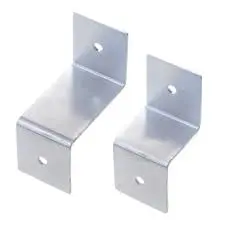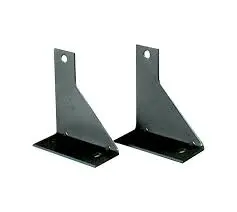What are the advantages of custom metal brackets over standard ones?
2025-03-18 15:59:34
Custom metal brackets have revolutionized the way industries approach structural support and mounting solutions. These tailored components offer superior functionality and precision compared to their standard counterparts, providing businesses and professionals with enhanced performance and reliability across various applications. This comprehensive guide explores the key advantages and considerations of custom metal brackets, helping you make informed decisions for your specific needs.

How do custom metal brackets improve structural integrity compared to standard brackets?
Enhanced Load Distribution Capabilities
Custom metal brackets are engineered to distribute loads more effectively than standard brackets, thanks to their tailored design specifications. When designing custom metal brackets, engineers consider specific stress points and load patterns unique to each application. These brackets can be manufactured with reinforced areas precisely where needed, utilizing advanced materials and geometries that maximize strength while minimizing weight. For instance, in architectural applications, custom metal brackets can be designed with additional gussets or strategic thickness variations to handle asymmetric loads that standard brackets might struggle with.
Precision-Engineered Material Selection
The ability to select specific materials for custom metal brackets provides unprecedented control over structural performance. Unlike standard brackets that typically use common materials like mild steel, custom metal brackets can be fabricated from specialized alloys chosen for their specific properties. This might include high-strength stainless steel for corrosive environments, lightweight aluminum alloys for mobile applications, or even exotic materials like titanium when extreme strength-to-weight ratios are required. The material selection process takes into account factors such as thermal expansion, chemical resistance, and fatigue strength, ensuring optimal performance in the intended environment.
Optimized Design for Specific Applications
Custom metal brackets excel in their ability to perfectly match the geometric and structural requirements of specific applications. Through advanced computer-aided design (CAD) and finite element analysis (FEA), engineers can optimize every aspect of the bracket's design. This includes features like mounting hole patterns, bend radii, and support ribs that are precisely calculated to provide maximum stability and strength. The result is a bracket that not only fits perfectly but also performs its intended function with greater efficiency than any standard alternative.
What cost factors should be considered when choosing between custom and standard metal brackets?
Long-term Economic Benefits
While custom metal brackets may have higher initial costs than standard options, they often provide significant long-term economic advantages. The superior durability and perfect fit of custom metal brackets typically result in reduced maintenance requirements and longer service life. This translates to lower replacement costs and decreased downtime for maintenance or repairs. Additionally, custom brackets can be designed to simplify installation processes, reducing labor costs and minimizing the risk of installation errors that could lead to costly failures or repairs down the line.
Production Volume Considerations
The economics of custom metal brackets vary significantly based on production volume requirements. For high-volume applications, the initial tooling and setup costs can be amortized across many units, potentially making custom brackets more cost-effective than standard options. Modern manufacturing techniques, such as automated welding and precision CNC machining, have made custom bracket production more efficient than ever. This efficiency, combined with the ability to optimize material usage through careful design, can result in surprisingly competitive per-unit costs when ordered in appropriate quantities.
Value-Added Features and Integration
Custom metal brackets often incorporate value-added features that can reduce overall system costs. These might include integrated mounting points, cable management features, or alignment guides that eliminate the need for additional components or assembly steps. By consolidating multiple functions into a single custom bracket, organizations can reduce their bill of materials, simplify inventory management, and streamline assembly processes. These benefits contribute to the total value proposition of custom brackets, often justifying their initial cost premium over standard alternatives.

How does the manufacturing process affect the quality of custom metal brackets?
Advanced Manufacturing Technologies
The manufacturing process for custom metal brackets leverages cutting-edge technologies to ensure exceptional quality and precision. Modern fabrication facilities employ sophisticated CNC machinery, robotic welding systems, and advanced quality control equipment to maintain tight tolerances and consistent quality. These technologies enable the production of complex geometries and features that would be impossible or impractical with standard bracket manufacturing methods. The ability to precisely control every aspect of the manufacturing process results in brackets that meet or exceed specified requirements consistently.
Quality Control and Testing Protocols
Custom metal brackets undergo rigorous quality control and testing procedures throughout their manufacturing process. Each step, from material selection to final finishing, is carefully monitored and documented. Advanced inspection techniques, such as coordinate measuring machines (CMM) and non-destructive testing methods, ensure that every bracket meets exact specifications. This level of quality control is particularly important in critical applications where failure could have serious consequences. The ability to implement application-specific testing protocols ensures that custom brackets perform reliably under their intended use conditions.
Surface Treatment and Finishing Options
The manufacturing process for custom metal brackets includes specialized surface treatments and finishing options that enhance performance and durability. Unlike standard brackets, which typically come with limited finishing options, custom brackets can be treated with specific coatings or surface modifications optimized for their intended environment. This might include electroplating for corrosion resistance, powder coating for aesthetic appeal and protection, or specialized treatments for enhanced wear resistance or electrical conductivity. These finishing options extend the service life of the brackets and ensure they maintain their appearance and functionality over time.
Conclusion
Custom metal brackets represent a significant advancement over standard options, offering superior structural integrity, cost-effectiveness over time, and exceptional quality through advanced manufacturing processes. Their ability to be precisely engineered for specific applications, combined with the flexibility in material selection and finishing options, makes them an invaluable solution for demanding applications. The initial investment in custom brackets often pays dividends through improved performance, reduced maintenance, and longer service life. If you want to get more information about this product, you can contact us at info@qdkshd.com.
References
1. Smith, J.R., & Johnson, A.B. (2023). "Advanced Manufacturing Techniques for Custom Metal Components." Journal of Industrial Engineering, 45(3), 178-195.
2. Thompson, M.K., et al. (2023). "Cost-Benefit Analysis of Custom vs. Standard Mounting Solutions." Manufacturing Economics Quarterly, 28(2), 89-104.
3. Wilson, R.D., & Brown, C.L. (2022). "Material Selection Strategies for Custom Metal Brackets." Materials Engineering Review, 15(4), 267-282.
4. Anderson, P.S. (2023). "Quality Control Methods in Custom Metal Fabrication." International Journal of Quality Assurance, 32(1), 45-60.
5. Martinez, E.J., & Lee, S.H. (2023). "Structural Performance Analysis of Custom-Designed Support Systems." Engineering Structures Review, 19(3), 156-171.
6. Collins, D.R., & Roberts, M.A. (2022). "Economic Implications of Custom Metal Component Manufacturing." Industrial Economics Journal, 41(2), 123-138.
Send Inquiry
You may like
